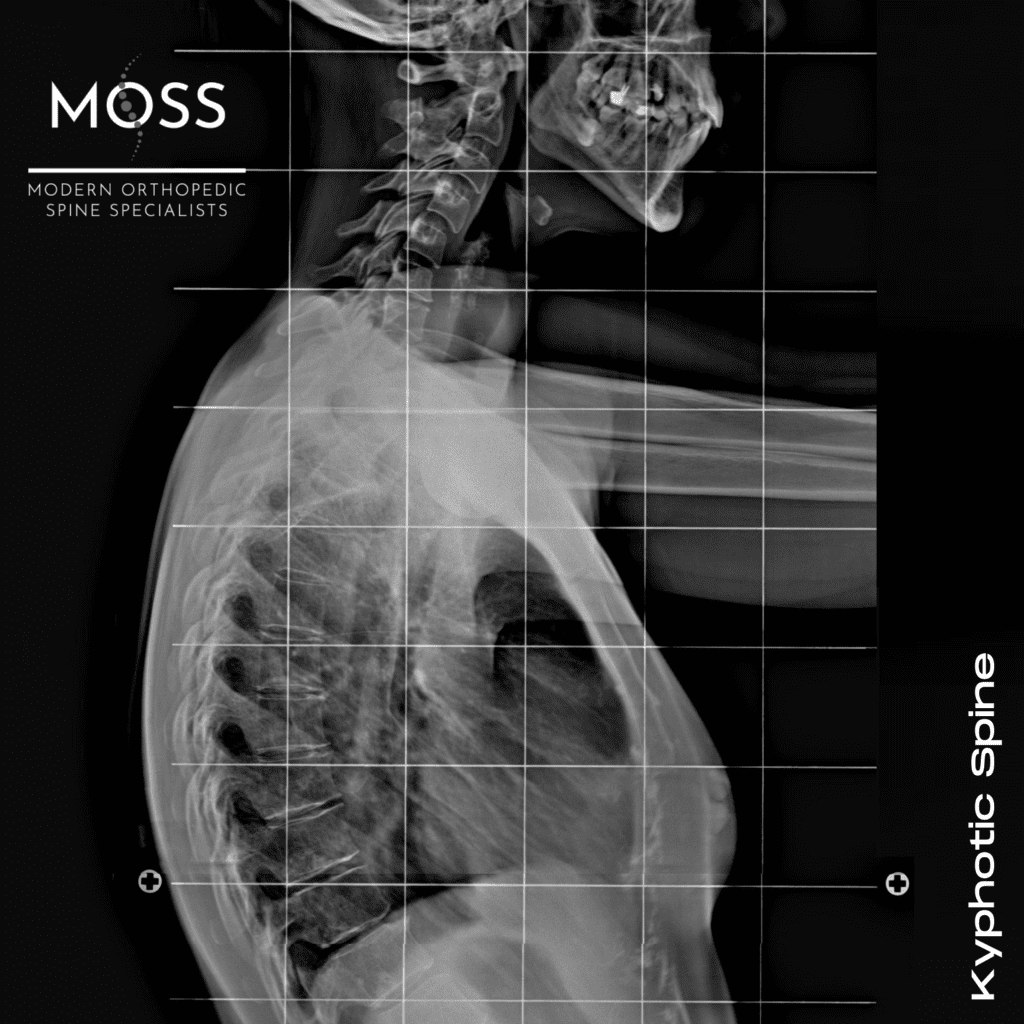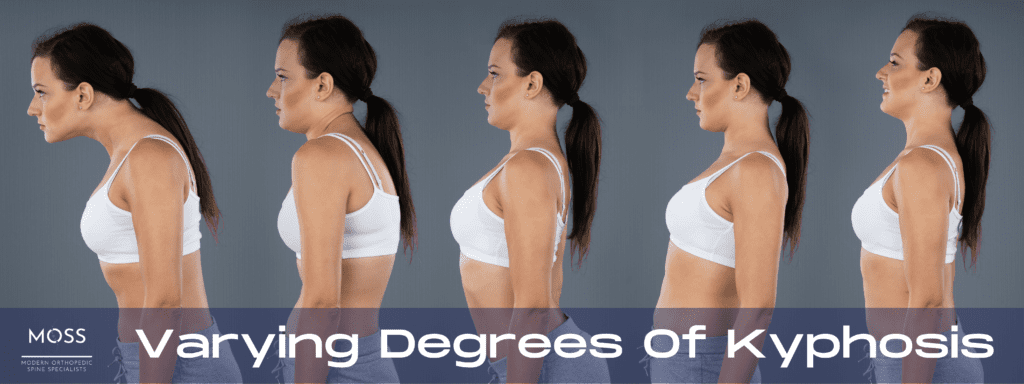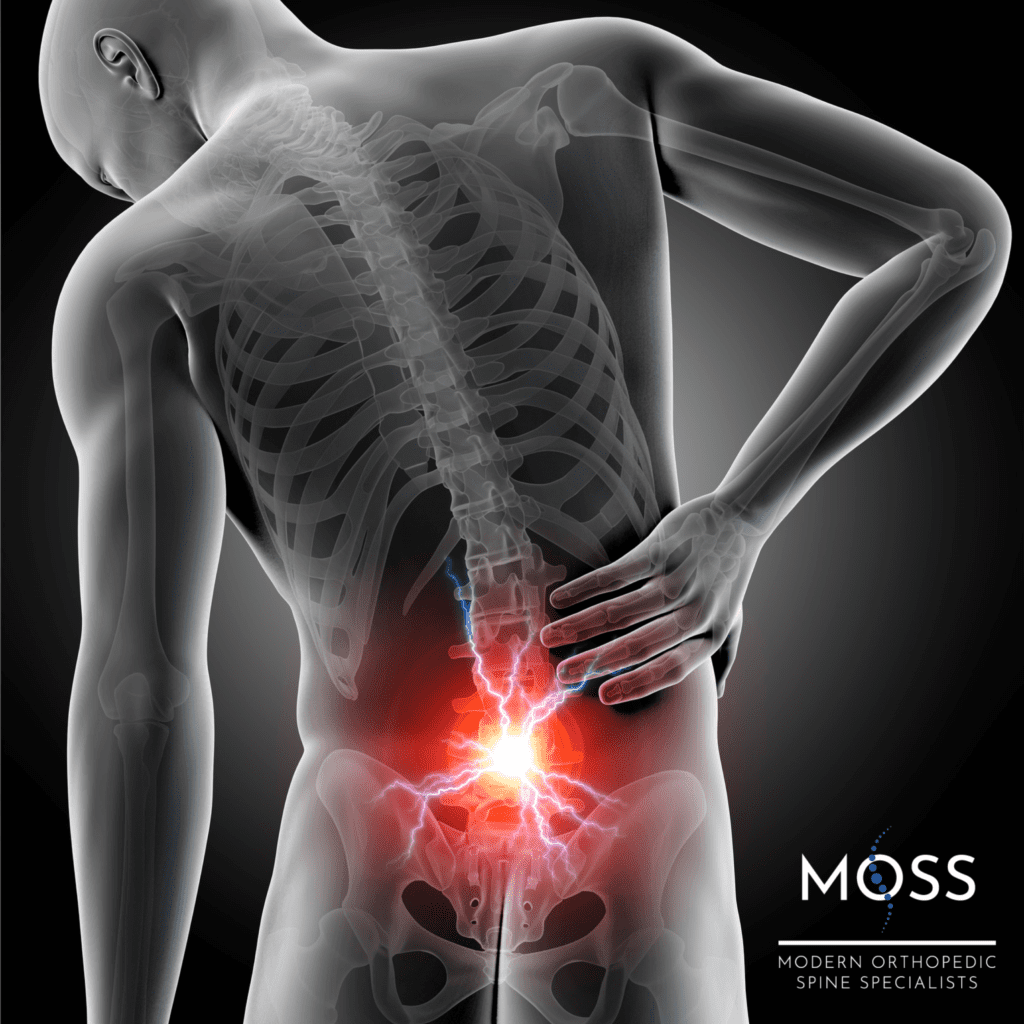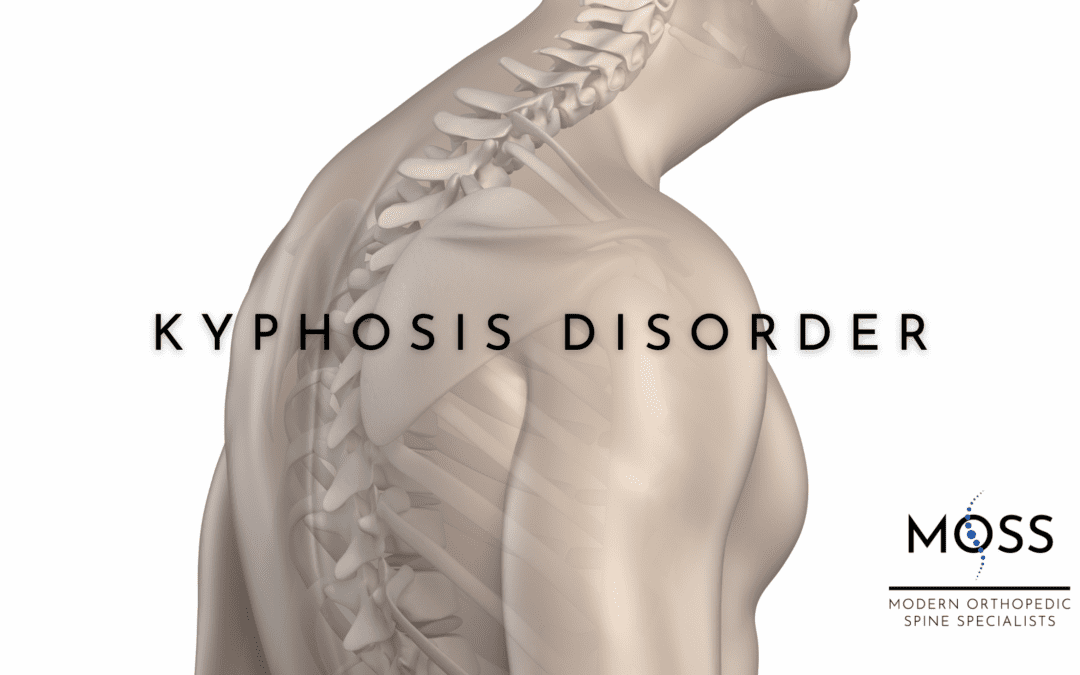Back pain can be debilitating, anxiety-inducing, and interfere with daily activities, but there are treatments! In our SPINE ANATOMY 101 post, we discussed the structure of the spine. With this understanding, we can delve into conditions where the spine is impaired and some corresponding treatments. Read on to learn about a common anomaly of the spine — kyphosis disorder.
What is kyphosis disorder?

A healthy spine naturally curves at the upper, middle, and lower portions. However, a spine with a kyphosis disorder has an exaggerated outward curve. This causes a hump in varying degrees of severity, depending on the individual and the factors contributing to the kyphosis. Milder cases may also be called a “roundback,” whereas the term “hunchback” might be applied to more severe cases.
The term Dowager’s hump may also be used to describe the “hump” that results from the forward curvature of the neck.
All those hours hunched over a computer keyboard and checking our phones take a toll on our neck and spine!

What causes kyphosis?
While birth defects and congenital malformations may cause kyphosis at a younger age, typically it is seen in older individuals as muscles that help maintain proper posture weaken and the spine degenerates with aging and other conditions.
Conditions like Scheuermann’s kyphosis become apparent in adolescence as growth spurts cause pain in the affected areas.
Common causes of kyphosis include:
- Postural — Poor posture and frequent “hunching over” due to activities such as hours spent in front of a screen with the head leaning forward and facing downward, as well as muscle weakness, can stretch out the ligaments and cause an exaggerated spinal curvature. This is the most common type of kyphosis.
- Aging — As muscles weaken and conditions like osteoporosis and arthritis increase, kyphosis begins to occur and progress.
- Birth defects — If bones of the spine are not properly developed before birth, abnormal curvature of the spine and scoliosis (sideways curvature of the spine that most commonly occurs during the pubertal growth spurt) can arise.
- Cancer and cancer treatments — Cancer, chemo, and radiation, as well as other medications, can cause osteoporosis and a weakening of the vertebrae.
- Disc degeneration — As one age, or with a lot of wear and tear, the cushiony discs between the vertebrae can shrink and cause an abnormal curvature.
- Disc herniation — This occurs when the softer inner portion of the intervertebral discs (rubbery discs that act as a cushion between the vertebrae, or individual bones of the spine) leak through to the tougher outer portion, causing pain, and/or weakness.
- Fractures and spinal injury — Vertebrae that are crushed and/or broken can cause postural problems and abnormal curvature.
- Muscle weakness — Our musculature is an integral part of our posture and plays an important role along with our skeletal system in maintaining good spine health. With muscle weakness, maintaining proper curvature and alignment becomes more difficult.
- Osteoporosis — This disease causes bones to thin and become brittle. In addition to making bones more susceptible to breaking, it causes them to shrink; and in the spine, it can cause problems with alignment and increased curvature.
- Scheurmann’s kyphosis — This is a condition where the vertebrae grow unevenly, causing mid to lower back pain, as well as neck pain. It is most commonly seen in adolescents.
- Syndromes – Certain syndromes, like Marfan syndrome and Ehlers-Danlos syndrome, can produce kyphosis.
“THERE IS NO GREATER JOY THAN TO BE ABLE TO HELP RESTORE FUNCTION AND PROVIDE PAIN RELIEF FOR THOSE IN NEED OF IT.”
—DR. ARMEN OGANESIAN, DO, MPH
Is kyphosis painful?
Mild kyphosis is typically seen with little to no pain or problems, but increased degrees of kyphosis can cause pain and significant symptoms.

What are the symptoms of kyphosis?
Not all kyphosis is symptomatic, aside from presenting cosmetic issues, but when global alignment of the spine is altered, symptoms are more likely to be present. These symptoms range from mild and barely noticeable to severe and debilitating.
Common symptoms of kyphosis:
- Pain
- Stiffness
- Exaggerated curvature or visible hump
- Fatigue
- Rounded shoulders
- Muscle weakness
- Problems with balance
- Hip pain
What are some complications of kyphosis?
Milder cases of kyphosis typically do not see serious complications, if any, but with advancing degrees of kyphosis, some of these complications may arise as it impairs flexibility, mobility, and activity:
- Body-image disturbance — Even when pain and other symptoms aren’t present, the abnormal appearance of the spine can cause embarrassment, especially among teens. In those cases where a brace is necessary, this can compound feelings of self-consciousness.
- Breathing impairment — More exaggerated curvature of the spine can cause pressure on the lungs, which can impair normal breathing.
- Digestive issues — These may result from pressure on the digestive tract. Sometimes, difficulty swallowing and acid reflux may be seen.
- Impaired physical functions — Muscles and movements are sometimes impaired as a result of kyphosis. This can interfere with daily activities, making normal day-to-day functions increasingly difficult.
- Numbness and tingling of the arms and legs, as well as weakness, may sometimes result from more severe rounding of the spine.
Are there treatments for kyphosis?
While milder cases of kyphosis do not typically require intervention, kyphosis of any degree can benefit from an evaluation by a qualified physician; however, more severe cases are likely to require some medical intervention to treat the excessive curvature and reduce symptoms.
Interventions for kyphosis include, but are not limited to:
- Monitoring — After an initial assessment, your doctor may want to see you periodically to watch progression and impairment. X-rays may be ordered, and this baseline is helpful in evaluating progression and change.
- Physical therapy — The goal is to reduce pain and impairment by strengthening the neck, back, and abdominal muscles, as well as recommending various stretches that can decrease tension and abnormal pulling on the spine.
- Braces — These may be recommended while the patient is still growing (as in Scheurmann’s kyphosis) but are discontinued once growth stops or satisfactory progress is made.
- Medications — NSAIDs (nonsteroidal anti-inflammatory drugs, like ibuprofen and naproxen) are sometimes used to reduce pain and inflammation if necessary but typically not recommended for long-term use.
- Weight loss — Even a small reduction in weight can reduce the workload of the spine and improve posture.
- Surgery — Surgical intervention may be necessary when all other treatment options have been ineffective and symptoms are debilitating, or when curvature is severe, as in some cases of Scheurmann’s where a curvature greater than 75 degrees is present.
Surgery is performed to improve alignment and decrease curvature, but it is reserved for more severe cases and when all other treatments have been ineffective.
If surgery is necessary, you can feel confident that Dr. Armen Oganesisian will treat you with care and compassion, as well as with the latest and least invasive techniques possible for your situation.
- OGANESIAN IS DEVOTED TO HIGH-QUALITY CLINICAL RESEARCH AND INNOVATION IN ENDOSCOPIC AND MINIMALLY INVASIVE SPINE SURGERY. IN ADDITION TO HIS EDUCATION, DR. OGANESIAN IS A MEMBER OF THE NORTH AMERICAN SPINE SOCIETY AND THE AMERICAN ACADEMY OF ORTHOPEDIC SURGEONS.
Kyphosis can range from mild to severe and can have a variety of causes and symptoms. Anyone with a kyphosis disorder can benefit from an evaluation and assessment, whether it is to provide a baseline for future monitoring or to recommend different treatment modalities to prevent progression and provide improvement. It is important to know that help is available!
For an individual consultation, contact Dr. Armen Oganesian at The Modern Spine Specialists today! Please contact The Modern Spine Specialists at 805-370-0748, or email us at info@themodernspine.com.
You can also visit our office at:
250 Lombard Street
Thousand Oaks, CA 91360


Recent Comments